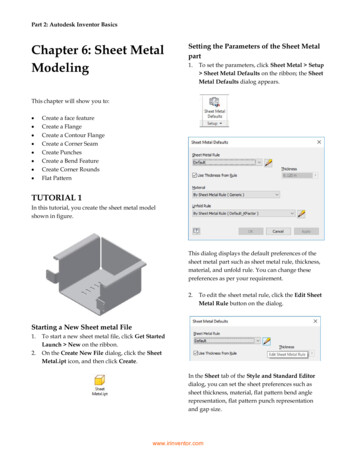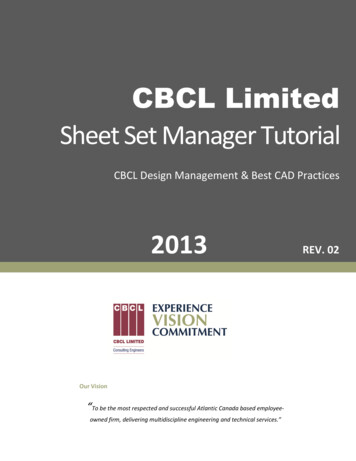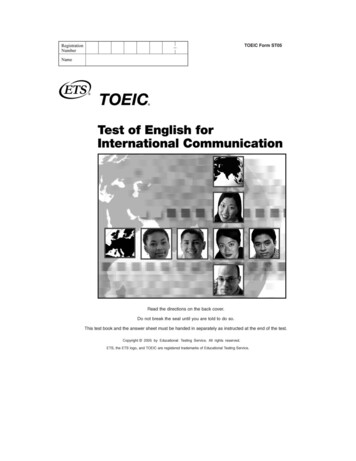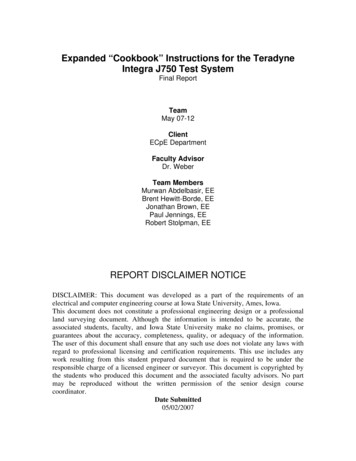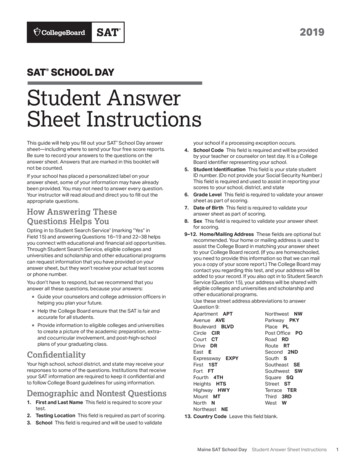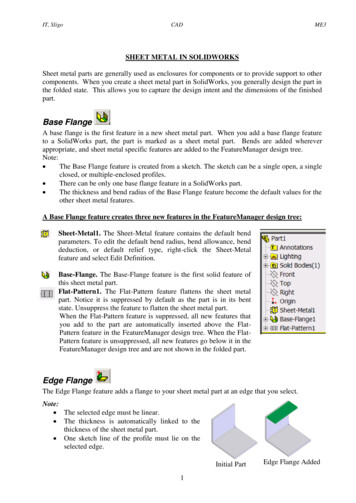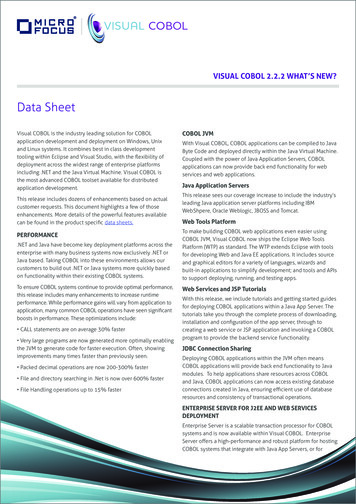
Transcription
VISUAL COBOL 2.2.2 WHAT’S NEW?Data SheetVisual COBOL is the industry leading solution for COBOLapplication development and deployment on Windows, Unixand Linux systems. It combines best in class developmenttooling within Eclipse and Visual Studio, with the flexibility ofdeployment across the widest range of enterprise platformsincluding .NET and the Java Virtual Machine. Visual COBOL isthe most advanced COBOL toolset available for distributedapplication development.This release includes dozens of enhancements based on actualcustomer requests. This document highlights a few of thoseenhancements. More details of the powerful features availablecan be found in the product specific data sheets.PERFORMANCE.NET and Java have become key deployment platforms across theenterprise with many business systems now exclusively .NET orJava based. Taking COBOL into these environments allows ourcustomers to build out .NET or Java systems more quickly basedon functionality within their existing COBOL systems.To ensure COBOL systems continue to provide optimal performance,this release includes many enhancements to increase runtimeperformance. While performance gains will vary from application toapplication, many common COBOL operations have seen significantboosts in performance. These optimizations include: CALL statements are on average 30% faster Very large programs are now generated more optimally enablingthe JVM to generate code for faster execution. Often, showingimprovements many times faster than previously seen. Packed decimal operations are now 200-300% faster File and directory searching in .Net is now over 600% faster File Handling operations up to 15% fasterCOBOL JVMWith Visual COBOL, COBOL applications can be compiled to JavaByte Code and deployed directly within the Java Virtual Machine.Coupled with the power of Java Application Servers, COBOLapplications can now provide back end functionality for webservices and web applications.Java Application ServersThis release sees our coverage increase to include the industry’sleading Java application server platforms including IBMWebShpere, Oracle Weblogic, JBOSS and Tomcat.Web Tools PlatformTo make building COBOL web applications even easier usingCOBOL JVM, Visual COBOL now ships the Eclipse Web ToolsPlatform (WTP) as standard. The WTP extends Eclipse with toolsfor developing Web and Java EE applications. It includes sourceand graphical editors for a variety of languages, wizards andbuilt-in applications to simplify development; and tools and APIsto support deploying, running, and testing apps.Web Services and JSP TutorialsWith this release, we include tutorials and getting started guidesfor deploying COBOL applications within a Java App Server. Thetutorials take you through the complete process of downloading,installation and configuration of the app server, through tocreating a web service or JSP application and invoking a COBOLprogram to provide the backend service functionality.JDBC Connection SharingDeploying COBOL applications within the JVM often meansCOBOL applications will provide back end functionality to Javamodules. To help applications share resources across COBOLand Java, COBOL applications can now access existing databaseconnections created in Java, ensuring efficient use of databaseresources and consistency of transactional operations.ENTERPRISE SERVER FOR J2EE AND WEB SERVICESDEPLOYMENTEnterprise Server is a scalable transaction processor for COBOLsystems and is now available within Visual COBOL. EnterpriseServer offers a high-performance and robust platform for hostingCOBOL systems that integrate with Java App Servers, or for
VISUAL COBOL 2.2.2 WHAT’S NEW?Data Sheetexposing COBOL systems as web services with no compromiseon performance as they continue to execute as native code.Using a graphical editor called the Interface Mapping Toolkit,COBOL developers can quickly create entry points into existingCOBOL programs that are then accessible to a wide range ofother programming languages and 3rd party toolsets.Creating a web service using the Interface Mapping Toolkit withinEclipseECLIPSE AND VISUAL STUDIOVisual COBOL continues to set the benchmark for COBOLapplication development with many new features designed toincrease efficiency of development teams and on-board newCOBOL developers faster than ever. New features include:Smart editing – COBOL source code can be edited in a varietyof styles including traditional fixed format as well as free format.The Visual COBOL editor in Eclipse and Visual Studio is nowsensitive to these different styles, adjusting keyboard handlingand preserving formatting (including comments) based on thecurrent source format.Copybook dependency view – A new tool window whichshows copybooks used within a program making it easy to finddependent source files. As well as seeing what copybooks agiven program is using, developers can also quickly identifywhich programs in the project share copybooks.Advanced COBOL Searches – COBOL Source Information is nowavailable enabling developers to quickly find items of interestsuch as fields, paragraphs and even COBOL verbs.COBOL Source Information output from Visual Studio showing alloccurrences of file IO usage within a programFaster project loads and builds – Visual Studio and Eclipseintegration has been optimized to provide better support for largercode bases. Projects load faster, background parsing and developertools are more responsive and improved project dependencyanalysis means only out of date source files are recompiled.Filter views – filtered views now organize source files andcopybooks into separate virtual folders. Developers can alsocreate customizable filters to organize source files based on fileextensions.Expanded source view – Introducing the expanded source filefunctionality within Visual Studio 2012. This view enables thedeveloper to see the entire program including all dependent copyfiles within a single editor view. Source files and copybooks cannow be edited inline and also show the effect of copy replacing.
VISUAL COBOL 2.2.2 WHAT’S NEW?Data SheetError Markers – icons now identify the source file in error withinthe Visual Studio Solution Explorer and Eclipse Package Explorer,making it quick to see at-a-glance which source files have problems.Eclipse – Visual COBOL now includes support for Eclipse 3.8 andEclipse 4.3.RESTful Web Services – Visual Studio users now also have accessto a new project template for creating RESTful web services usingASP.NET. RESTful web services have gained in popularity and cannow be used to access COBOL programs on the backend.Visual Studio outlining on paragraphs and sections – The VisualStudio editor now provides outlining on COBOL sections andparagraphs making it possible to get extra screen estate byhiding sections of code.Eclipse enhanced error markers and copybook dependency viewMulti-output .NET projects – COBOL projects targeting .NET cannow generate multiple executables per project making it easierto move large codebases into .NET.Quickfix hints - Missing copybooks can now be fixed up quicklywithin Eclipse using an automatic quick fix tool.Copybook projects – Eclipse now supports copybook projectswhich allow copybooks to be easily shared and accessed acrossmultiple projects within the workspace without the need to setupexternal folders.OpenESQL Assistant – The OpenESQL Assistant makes it possibleto quickly generate and test COBOL snippets that connect toand query relational databases. This is now available within bothEclipse and Visual Studio.Azure support – Microsoft Azure support is now included asstandard in Visual Studio. This support enables .NET COBOLapplications to be deployed into the Microsoft Azure Cloud.Collapsible regions in Visual StudioVisual Studio ‘watch’ window – The watch window now supportsmixed hex/text data formats. Developers can view the same fieldin both hex/text without needing to switch between modes.COBOL LANGUAGEMicro Focus is committed to evolving the COBOL language to ensureit continues to offer the best choice for business applications. In thisrelease new COBOL syntax for managed code includes: Optional parameters Named parameters Event attach/detach Delegate combining
VISUAL COBOL 2.2.2 WHAT’S NEW?Data SheetThe Visual COBOL Samples Browser provides examples of how touse these new features.VISUAL STUDIO 2013Visual Studio is the flagship development platform fromMicrosoft. With integration already in Visual Studio 2010 and2012, Micro Focus is pleased to announce support for COBOLdevelopment within Visual Studio 2013. To take a closer lookat the features for yourself, start your trial herewww.microfocus.com/vs2013PLATFORM SUPPORTMicro Focus is committed to assuring the long term success ofits customers’ applications. Key to this is our focus on COBOLapplication portability across the enterprise. Micro Focusexecutes thousands of test cases across all supported operatingsystem and processor combinations, including 32 and 64-bit,.NET and JVM, ensuring COBOL applications run with the samereliability our customers have come to depend on no matterwhere the application is deployed.Supported Operating Systems are listed below - if your operatingsystem is not covered here, please discuss this with your accountmanager as we may still have coverage for your environment:Windows on Intel x86/x64 Windows Vista Windows XP Windows 7 Windows 8.1 Windows Server 2003 Windows Server 2008 Windows Server 2012 R2Visual Studio 2013 – showing enhanced scrollbar and previewwindowAIX6.1 / 7.1Linux on Intel x86/x64SUSE 11 SP2/SP3Red Hat 5.10, 6.5, 7.0Oracle Linux* 6.5, 7.0* Includes both Red Hat Compatible and Oracle UnbreakableKernelsz/Linux on 390SUSE 11 SP2/SP3Red Hat 6.5, 7.0
VISUAL COBOL 2.2.2 WHAT’S NEW?Data SheetSolarisSUPPORTED APPLICATION SERVERS FOR ENTERPRISESERVERSolaris 10, 11.1 on SPARCSolaris 11.1 on IntelMicro Focus has tested J2EE deployment with Enterprise Serveragainst these configurations:HPUX WebSphere 8.0, 8.5HPUX 11i v3 (11.31) on Itanium Oracle WebLogic Server 10.3.5, 12.1.1SUPPORTED DATABASES JBoss Application Server 5.1, 6.1Micro Focus supports ODBC, JDBC and ADO.NET database accessusing OpenESQL. Supported database configurations include:Middleware Microsoft SQL Server 2008 R2, 2012DEVELOPMENT ENVIRONMENTS IBM DB2 9.5, 9.7, 10.1, 10.5 Visual Studio 2010, 2012, 2013 Oracle 11g R1, 11g R2, 12c Eclipse 3.8, 4.3Other relational databases are also supported. Please contactyour account manager if you have other database requirements.MICROSOFT .NETPlease note Eclipse support is provided on Windows and Linuxsystems. Remote development support is available for Unixplatforms using the features of Visual COBOL Development Hubin combination with Visual COBOL for Eclipse.All versions of the Microsoft .NET Framework to version 4.5.2 aresupported.For More InformationSUPPORTED APPLICATION SERVERS FOR COBOL JVMInterested in finding out more details or upgrading to VisualCOBOL? Ask us about our free of charge Value Profile service.Micro Focus has tested COBOL JVM deployment against theseknown configurations:Tomcat 7.0.39JRE 1.6.027 Tuxedo and Tuxedo ART 12.1.3chttp://www.microfocus.com/services/value profile day service.aspxJBoss Application Server 6.1 JRE 1.6.027Oracle WebLogic 12.1.1JRE 1.6.027 IBM JRE 1.6.1 SR10 FP1For additional information please visit: www.microfocus.comIBM WebSphere 8.5JRE 1.6.027 IBM JRE 1.6.1 SR10 FP1 2014 Micro Focus Limited. All rights reserved. MICRO FOCUS, theMicro Focus logo, among others, are trademarks or registered trademarksof Micro Focus Limited or its subsidiaries or affiliated companies in theUnited Kingdom, United States and other countries. All other marks arethe property of their respective owners.
Visual Studio 2013 - showing enhanced scrollbar and preview window The Visual COBOL Samples Browser provides examples of how to use these new features. VISUAL STUDIO 2013 Visual Studio is the flagship development platform from Microsoft. With integration already in Visual Studio 2010 and 2012, Micro Focus is pleased to announce support for COBOL
